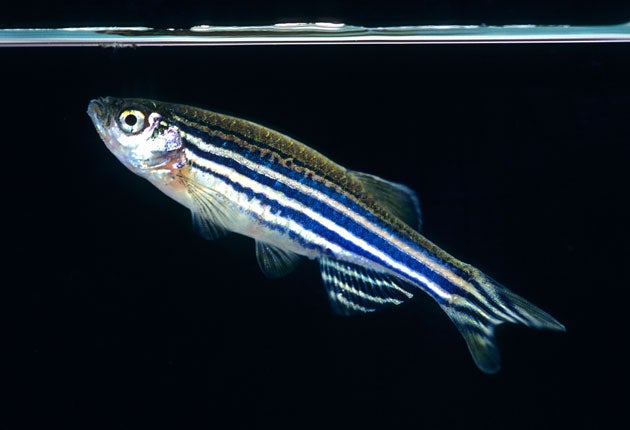The fish in your tank that could be the answer to heart disease

A small tropical fish that normally lives in the River Ganges and is commonly found in pet fish tanks could trigger a revolution in the treatment of heart disease and the end of heart-transplant surgery.
Scientists believe that the zebrafish's astonishing ability to regenerate its cardiac muscle might lead to the discovery of new drugs and treatments that will one day allow the human heart to heal itself after being damaged during a heart attack.
Medical researchers have already discovered a small protein molecule in zebrafish that appears to play a critical role in orchestrating the repair of damaged cardiac muscle. A zebrafish can repair up to 20 per cent of its heart muscle within weeks of it being lost.
Heart specialists believe that studying the zebrafish could provide vital clues about how to repair human cardiac muscle. The research might one day lead to an alternative to the transplant operations that are the only hope for thousands of patients now.
"If we could find a biological way of repairing damaged cardiac muscle, it would certainly obviate the need for heart transplants for some people who have had heart attacks," said Professor Peter Weissberg, medical director of the British Heart Foundation. The BHF, the biggest funder of heart research in Britain, yesterday announced a drive to raise an extra £50m over the next five years for spending on new developments in regenerative medicine, including studies into the innate repair mechanisms of the striped zebrafish.
"Since the BHF's inception 50 years ago, we've made great strides in medical research to better diagnose and treat people with all kinds of heart problems. But the biggest issue that still eludes us is how to help people once their heart has been damaged by a heart attack," Professor Weissberg said.
"Scientifically, mending human hearts is an achievable goal and we really could make recovering from a heart attack as simple as getting over a broken leg. But we need to spend £50m to make this a reality, and currently the resources and investment we need are simply not available," he said.
Five years ago, discussions about repairing damaged heart tissue centred on the idea of transplanting stem cells that could grow into fully mature cardiac muscle. However, more recent research suggests that it may be possible to stimulate latent stem cells that are already present in the human heart, Professor Weissberg said.
More people than ever before are surviving heart attacks but they often have to live with severely damaged cardiac tissue that can seriously affect their quality of life. The aim of the new research initiative is to help these people to regain their mobility, just as many transplant patients are able to live relatively normal lives, he said.
Over the last few decades, death rates from heart attack have fallen but heart failure rates have risen. In 1961, an estimated 100,000 people in the UK had heart failure, but an ageing population and the fact that more people are now surviving heart attacks has pushed this figure up to more than 750,000 today.
"We have a burgeoning epidemic of heart failure in this country... and we know that the zebrafish is able to regenerate its heart muscle to an extraordinary extent. There is a biological trick there that we need to learn from and adapt to human beings," Professor Weissberg said.
Professor Paul Riley of the Institute of Child Health, University College London, said that a protein molecule called thymosine beta-4, which is found in zebrafish, could become the basis of a new heart-repair drug. The protein seems to control the growth of the epicardium membrane, which surrounds the heart, so that it triggers the formation of new cardiac tissue and blood vessels.
"We hope to find similar molecules or drug-like compounds that might be able to stimulate these cells further. We'd really like to translate this to humans. It's an example to resident stem-cell repair," Professor Riley said.
Professor Weissberg warned that it could still take many years before the research leads to effective treatments: "In terms of main-line treatment, this might be eight to 10 years away. But if somebody cracks it in the next year or two things could accelerate very fast."
A fish called wonder
* The zebrafish displays an extraordianary ability to rebuild its heart muscle after it becomes damaged. A blood clot forms almost immediately around the damaged area to limit bleeding. The epicardium membrane surrounding the heart then quickly grows around the clot and stimulates the re-growth of new cardiac muscle and blood vessels. With time, the wounded heart returns to almost its original shape, size and pumping ability.
* Zebrafish and humans are both vertebrates (animals with backbones) and their hearts share some common characteristics, although the human heart has four chambers whereas the zebrafish heart has just two. Nevertheless, scientists believe that the growth factors controlling the regeneration of zebrafish hearts could also be used to stimulate the latent stem cells which appear to be present in human hearts.
Join our commenting forum
Join thought-provoking conversations, follow other Independent readers and see their replies
Comments